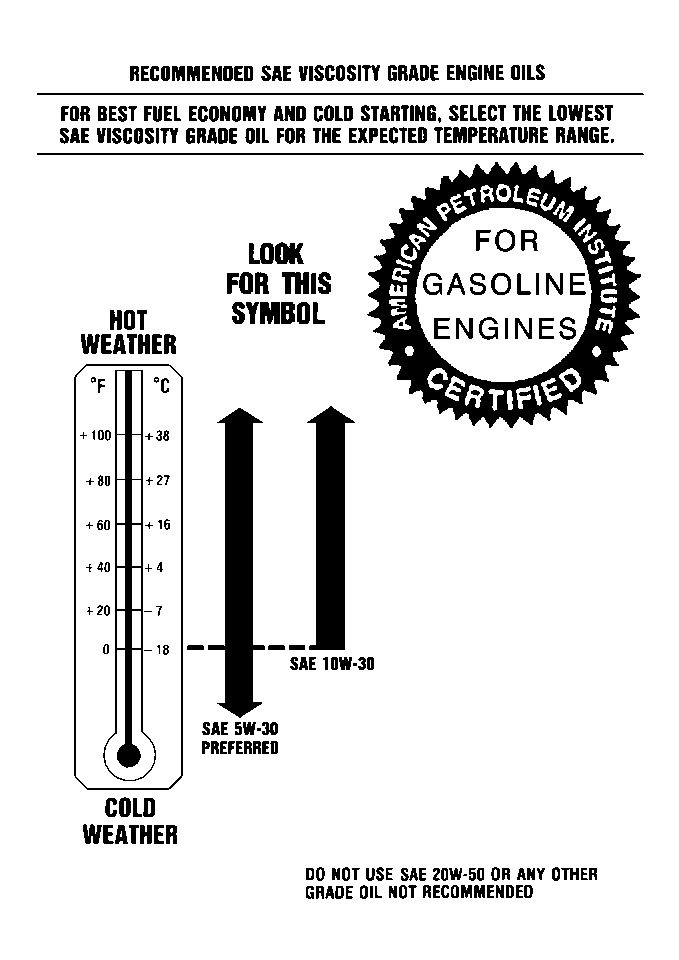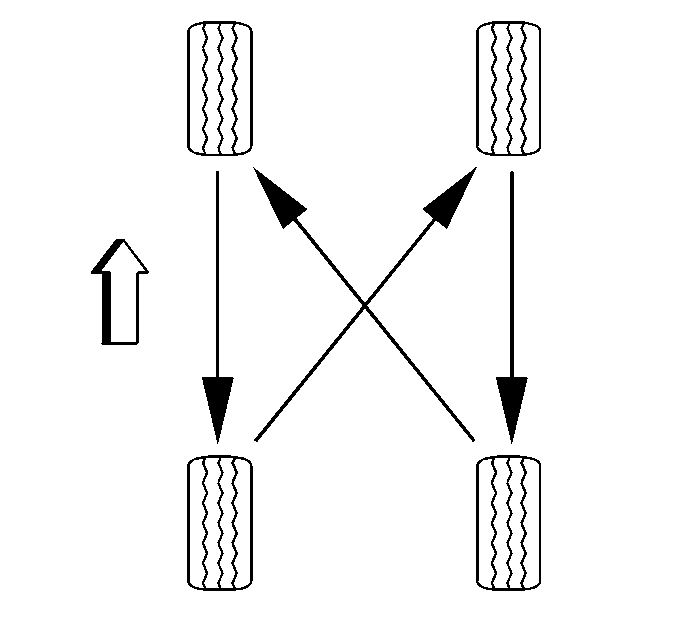For time and/or mileage intervals of scheduled maintenance items, refer to Maintenance Schedule .
The following text and illustration describe the details of the required scheduled maintenance services.
For information on the proper fluids and lubricants to use, refer to Fluid and Lubricant Recommendations .
Engine Oil and Oil Filter Change
Replace the engine oil and the engine oil filter.
For vehicles without an oil cooler, refer to Engine Oil and Oil Filter Replacement in Engine Mechanical.
Engine Oil Quality
Oils of the proper quality for the vehicle can be identified by looking for the STARBURST symbol. The STARBURST symbol indicates that the oil has been certified by the American Petroleum Institute (API), and is preferred for use in gasoline engines.
Engine Oil Viscosity

Notice: Using oils of any viscosity other than those recommended could result in engine damage. When choosing an oil, consider the range of temperatures the vehicle will be operated in before the next oil change. Then, select the recommended oil viscosity.
SAE 5W-30 is the only viscosity grade recommended for your vehicle.
Use only oils which have the API Starburst symbol and which are also identified as SAE 5W-30.
If the temperature range is 0°F (-18°C) or above SAE 10W-30 oil which has the API Starburst symbol is acceptable if SAE 5W 30 oils is not available. Areas where the temperature falls below -20°F (-29°C), it is recommended either an SAE 5W-30 synthetic oil or and SAE 0W-30 oil. Both will provide easier cold starting and better protection for the engine at extremely low temperatures. Do not use other viscosity grade oils, such as SAE 10W-40 or SAE 20W-50 under any conditions.
Tire and Wheel Inspection and Rotation
Tires should be rotated every 10 000 km to 13 000 km (6,000 to 8,000 miles).
Caution: Rust or dirt on a wheel, or on the parts to which it is fastened, can make wheel nuts become loose after a time. The wheel could come off and cause an accident. When you change a wheel, remove any rust or dirt from places where the wheel attaches to the vehicle. In an emergency, you can use a cloth or a paper towel to do this; but be sure to use a scraper or wire brush later, if you need to, to get all the rust or dirt off.

Check the tires for abnormal wear or damage. If irregular or premature tire wear exists, refer to Tire Diagnosis - Irregular or Premature Wear in Tires and Wheels.
Ensure the spare tire is stored securely. Push, pull, and then try to rotate or turn the tire. If it moves, use the folding wrench to tighten the cable. Refer to Tire and Wheel Removal and Installation in Tires and Wheels.
Rotate the tires to equalize the wear and obtain maximum tire life. Refer to Tire Rotation in Tires and Wheels.
When rotating tires, always use the correct rotation pattern shown here.
Do not include the compact spare tire in tire rotation.
After the tires have been rotated, adjusted the front and rear inflation pressures as shown on the Certification/Tire label. Ensure that all wheel nuts are properly tightened. Refer to Approximate Fluid Capacities .
Reset the check tire pressure system, if equipped. Refer to Tire Pressure Monitor Procedure in Tire Pressure Monitoring.
Make certain that all wheel nuts are properly tightened. Refer to Fastener Tightening Specifications in Tires and Wheels.
Brake System Inspection
Inspect brake lines and hoses for proper hook-up binding, leaks, cracks or chafing. Refer to Brake Pipe and Hose Inspection in Hydraulic Brakes. Inspect disc brake pads for wear. Refer to Brake Pad Inspection in Disc Brakes. Inspect the rotors for poor surface condition. Inspect other brake system components, including the brake calipers and the parking brake. Check the parking brake adjustment. The brakes may need to be inspected more often if the customer driving habits or conditions result in frequent braking.
Automatic Transmission Service
Change the transmission fluid and the transaxle fluid filter according to the maintenance schedule intervals. Use the proper fluids. For the fluid and filter changing procedure refer to Transmission Fluid Filler Tube and Seal Replacement in Automatic Transmission/Transaxle.
For time and/or mileage intervals of scheduled maintenance items, refer to Maintenance Schedule .
Drive Belt Inspection
Inspect the drive belt according to the maintenance schedule intervals.
For time and/or mileage intervals of scheduled maintenance items, refer to Maintenance Schedule .
Inspect the drive belt for the following:
| • | Cracks |
| • | Fraying |
| • | Wear |
| • | Proper tension |
Replace as needed. For drive belt replacement, refer to Drive Belt Replacement in Engine Mechanical.
Cooling System Service
Drain, flush and refill the cooling system with new coolant. Refer to Cooling System Draining and Filling in Engine Cooling.
Spark Plug Replacement
Replace the spark plugs according to the maintenance schedule intervals.
For the time and/or mileage intervals of scheduled maintenance items, refer to Maintenance Schedule .
For information on the correct type of spark plug, refer to Maintenance Items .
Spark Plug Wire Inspection
Clean the spark plug wires and inspect for burns, cracks or other damage. Ensure that the fit between the spark plug wire boots at the spark plugs and at the coils is snug. Replace the spark plug wires as needed.
Air Cleaner Filter Replacement
Replace the air cleaner filter according to the maintenance schedule intervals. For time and/or mileage intervals of scheduled maintenance items, refer to Maintenance Schedule .
For information on the correct type of air cleaner filter, refer to Maintenance Items .
For air cleaner filter replacement procedure, refer to Air Cleaner Element Replacement or Air Cleaner Assembly Replacement in Engine Controls.
